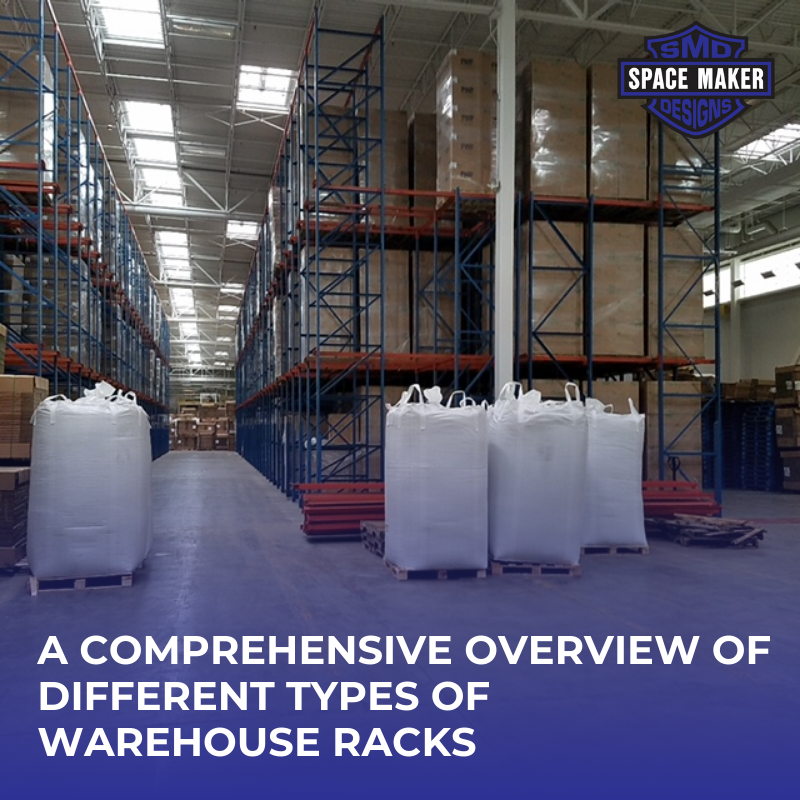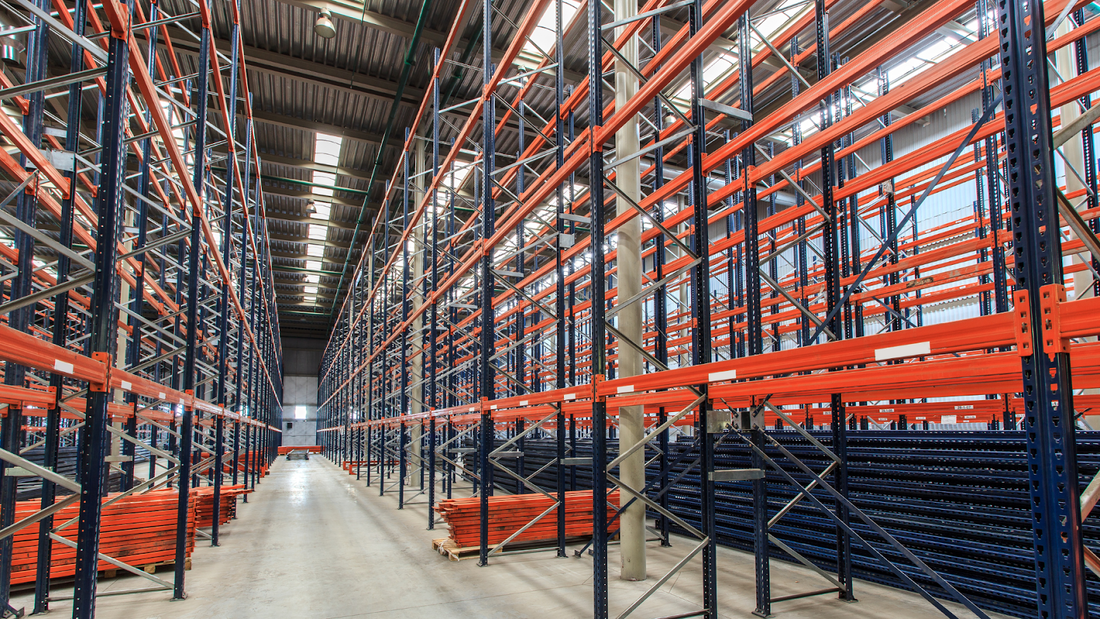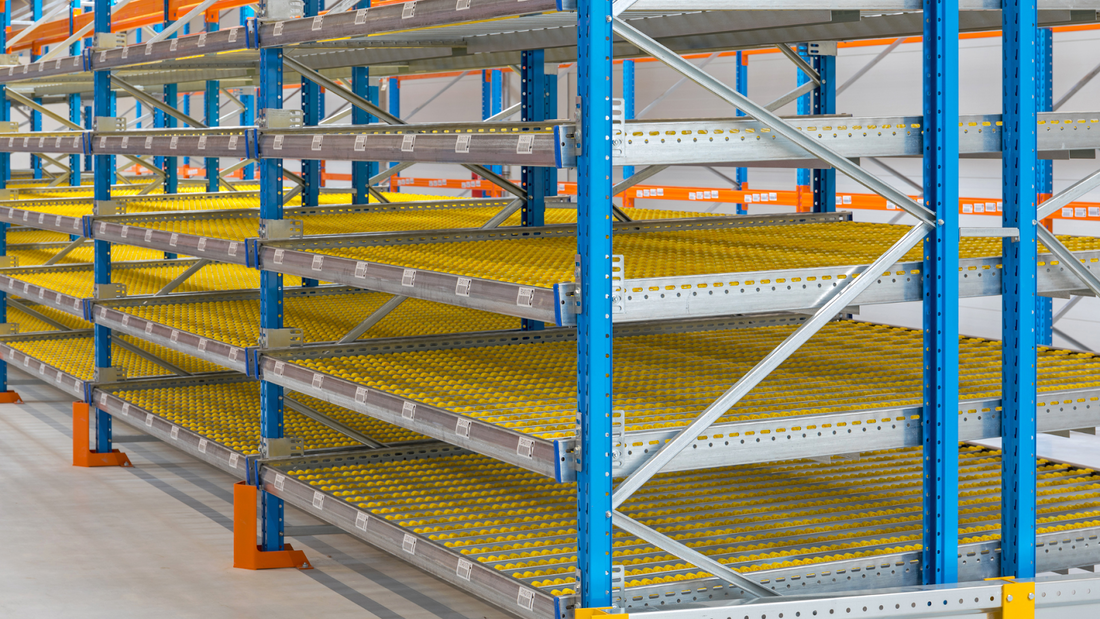Efficient warehouse management hinges on the strategic use of storage solutions, and selecting the right racks is paramount. In this comprehensive guide, we’ll discuss everything you need to know about warehouse racks, including their unique features, advantages, and optimal use cases.
At Space Maker Designs, we understand the critical role of warehouse racks in optimizing operations. Our expertise spans over a century, ensuring we offer top-notch products and services to meet specific warehousing needs. When you’re ready to revolutionize your warehouse with the perfect racks, contact us! Your journey to an optimized warehouse begins here.
At Space Maker Designs, we understand the critical role of warehouse racks in optimizing operations. Our expertise spans over a century, ensuring we offer top-notch products and services to meet specific warehousing needs. When you’re ready to revolutionize your warehouse with the perfect racks, contact us! Your journey to an optimized warehouse begins here.
What Are Warehouse Racks?
Warehouse racks are specialized storage systems designed to efficiently store and organize goods in a warehouse or distribution center. These racks provide a structured and space-saving solution for storing items of varying sizes, shapes, and weights.
Why Are Warehouse Racks Important?
Warehouse racks are crucial for several reasons:
- Enhanced Organization: Warehouse racks provide an organized and structured system for storing goods. They enable easy categorization, labeling, and accessibility of products. This organization simplifies inventory management and retrieval processes, reducing errors and ensuring that items are readily available when needed.
- Inventory Control: Warehouse racks provide visibility into stock levels and help prevent overstocking or stockouts. This control minimizes carrying costs and ensures a balance between supply and demand.
- Increased Efficiency: Properly designed and configured warehouse racks reduce the time and effort required to locate and retrieve products, contributing to higher operational efficiency.
- Improved Safety: Safety is a top priority in warehouse operations. Warehouse racks help create a safer working environment by reducing clutter and preventing goods from being haphazardly stacked.
How Do Warehouse Racks Work?
Warehouse racks work on the principle of vertical storage, utilizing the warehouse’s height. They consist of a framework of upright columns, cross beams, and shelves that provide support for goods. Forklifts or other material handling equipment are typically used to load and unload items onto the racks. The design and configuration of the racks allow for easy accessibility and efficient use of space.
Unlock Your Warehousing Potential With Space Maker Designs
Experience top-quality storage solutions for your warehouse with Space Maker Designs, your trusted partner in optimizing storage space and warehouse operation. Here's why you should choose us:
- Quality Refurbished Rack Solutions: We're the South's largest refurbisher of pallet racks, cantilever racks, drive-in racks, pallet-flow racks, push-back racks, and mezzanines, all backed by a 10-year warranty against kit damage.
- Aesthetic Excellence: Our advanced powder-coat and baked-on enamel paint lines ensure our refurbished products look brand new at a fraction of the cost.
- Nationwide Reach: From Systems Integration to Auto-CAD Layout and Design, Installation Services, Delivery, and Pallet Rack Repair, our services span coast to coast.
- Tailored Warehousing Solutions: We leverage our in-depth knowledge and experience to deliver storage solutions tailored to your warehousing needs.
Factors To Consider When Choosing Warehouse Racks
Several factors should be evaluated before choosing warehouse racks to ensure they meet your specific needs:
- Storage Requirements: Assess the types of goods you intend to store. Consider their dimensions, weight, and quantity – different warehouse racks are designed to accommodate specific goods.
- Warehouse Layout: Evaluate the available space within your warehouse. The layout design and space constraints will influence the choice of rack configurations. This includes determining whether you have sufficient vertical space for tall racks or if space is limited, requiring compact storage solutions.
- Accessibility: Consider how frequently you need to access certain items. High-demand products should be stored in accessible locations. This ensures efficient order fulfillment and minimizes handling time.
- Budget: Seek cost-effective rack solutions that align with your financial resources. While cost is a significant factor, it's crucial not to compromise on the quality and safety of the chosen racks.
- Future Scalability: Choose warehouse racks that can adapt to changes in your storage needs. Selecting racks that allow for future scalability ensures your storage solution remains relevant as your business expands or your product range evolves.
Discovering The Range Of Warehouse Rack Types
To find the best warehouse rack for your needs, explore these common types of warehouse racks:
Selective Pallet Racks
Selective pallet racks provide direct access to each pallet, making them perfect for products with high turnover rates. They're versatile and easily adjustable, adaptable to changing storage needs. This type is widely used for its efficiency in handling diverse products.
Drive-In And Drive-Through Racks
Engineered for high-density storage, these racks allow forklifts to enter the rack system. Drive-in racks follow a last-in, first-out (LIFO) storage method, making them suitable for items with lower turnover rates. Drive-through racks operate on a first-in, first-out (FIFO) basis, which works best for goods with higher rotation needs.
Cantilever Racks
Cantilever racks are specialized for storing long, bulky items like lumber, pipes, and furniture. They feature arms extending from upright columns, enabling easy loading and unloading. This type is indispensable for industries dealing with oversized or irregularly shaped products.
Push Back Racks
Utilizing a cart system, push-back racks enable the storage of multiple pallets in a deep lane. This high-density storage solution is ideal for products with multiple SKUs and limited stock rotation. It maximizes space utilization while ensuring accessibility to a range of goods.
Gravity Flow Racks
Gravity flow racks implement a gravity-fed system, allowing products to flow from the loading end to the unloading end. This type is excellent for high-volume order picking, ensuring efficient stock rotation and space utilization. It's particularly beneficial for industries with a need for quick access to high-demand products.
How Do You Organize A Warehouse Rack?
To organize a warehouse rack effectively, here are some key steps to follow:
- Categorize and prioritize: Begin by categorizing your inventory based on factors like size, weight, and frequency of use. Prioritize frequently accessed items for convenient placement near the entrance.
- Utilize vertical space: Warehouse racks allow for vertical storage, so utilize the available height. Use taller racks for lightweight items and reserve lower racks for heavier products.
- Implement a labeling system: Clearly label each rack and shelf to facilitate easy identification and retrieval of items. This labeling system could be alphanumeric or color-coded.
- Consider accessibility: Arrange the racks in a way that promotes ease of access. Keep frequently accessed items at a reachable height and ensure adequate aisle space for maneuverability.
Safety Measures In Warehouse Rack Usage
Safety is paramount in warehouse operations, so follow these measures for a secure working environment:
- Regular Inspections: Conduct routine checks for any signs of damage, such as bent or corroded sections. Promptly replace any compromised parts to maintain structural integrity.
- Load Capacity Adherence: Strictly adhere to the recommended load capacity of each rack. Overloading can lead to structural failure, posing risks to both personnel and inventory.
- Floor Anchoring: Securely anchor racks to the floor to prevent any possibility of tipping or collapsing. This anchoring ensures stability during loading and unloading activities.
- Staff Training: Provide thorough training to warehouse staff on proper loading and unloading techniques. Knowledgeable personnel can prevent accidents and injuries associated with rack usage.
- Implement Protective Measures: Employ protective equipment like rack guards and end-of-aisle protectors. These measures act as a safeguard against accidental impacts and collisions.
Maintenance And Durability Of Racking Systems
To extend the lifespan and durability of warehouse racking systems, consider these maintenance tips:
- Thorough Cleaning: Conduct regular cleaning to eliminate dust, debris, and potential corrosion sources. A clean environment not only prolongs rack life but also ensures a safe and hygienic workspace.
- Scheduled Maintenance: Establish a structured schedule for inspections and maintenance. Address identified issues promptly, preventing potential hazards and fortifying your racking system’s durability.
- Operator Training: Provide comprehensive training for forklift operators. Proficient handling minimizes the risk of accidental rack damage during loading and unloading processes.
Benefits Of Warehouse Racks
Here's why investing in warehouse racks is a game-changer:
- Maximized Storage Capacity: Warehouse racks revolutionize how you use space. By going vertical, they unlock untapped storage potential. It's not just about square footage; it's about cubic footage. This means more products are stored efficiently, ultimately increasing your capacity.
- Improved Inventory Management: Picture a warehouse where every item has its place, clearly visible and easily accessible. This creates order out of potential chaos, reducing errors and ensuring your inventory is always accounted for.
- Enhanced Accessibility: Time is money in any warehouse. With organized racks, finding and retrieving items becomes a breeze. It's about efficiency and productivity, allowing your team to focus on what matters most.
- Flexibility And Adaptability: Businesses evolve, and so do their storage needs. Warehouse racks come in various types – whether it's bulk storage, specialized items like lumber or piping, or high-turnover goods, there's a rack for that.
What Are The Alternatives To Warehouse Racks?
If warehouse racks don’t currently suit your needs, consider these alternatives:
- Shelving units: Shelves provide a simple and cost-effective storage solution for smaller warehouses or areas with limited space. They are ideal for storing items that do not require pallets or significant vertical storage.
- Mezzanine systems: Mezzanines create additional storage space by utilizing the vertical height of a warehouse. They are ideal for accommodating a wide range of items while maintaining accessibility.
- Mobile racking systems: These movable racks can be repositioned to create aisle space where and when needed. They're particularly beneficial for warehouses with fluctuating storage requirements.
Final Thoughts
Understanding the diverse array of warehouse racks is crucial for optimizing your storage solutions. From the efficiency of selective pallet racks to the space-saving benefits of gravity glow racks, the right choice can revolutionize your warehouse operations.
At Space Maker Designs, we're your partner in optimizing your storage space. Whether you're seeking selective pallet racks, drive-in racks, cantilever racks, push-back racks, or gravity flow racks, we have the expertise and products to transform your warehouse into a well-oiled, efficient machine. Your journey to a more organized, efficient, and cost-effective warehouse starts with us – contact us today to get started!
Want to learn more about racks? Read:
At Space Maker Designs, we're your partner in optimizing your storage space. Whether you're seeking selective pallet racks, drive-in racks, cantilever racks, push-back racks, or gravity flow racks, we have the expertise and products to transform your warehouse into a well-oiled, efficient machine. Your journey to a more organized, efficient, and cost-effective warehouse starts with us – contact us today to get started!
Want to learn more about racks? Read:
- Rack Inspections: Ensuring Safety and Compliance
- 7 Factors to Consider When Buying Pallet Racks in Dallas
- Drive-In Rack: Cost-Effective Warehouse Storage Solutions
FAQs
What are the common materials used in warehouse rack construction?
Warehouse racks are typically constructed from materials such as steel, aluminum, and occasionally, wood, depending on the desired durability and load-bearing capacity.
Can I customize warehouse racks to fit my specific storage needs?
Many manufacturers offer customizable rack solutions tailored to your unique requirements. Customization ensures that your racks align perfectly with your storage needs.
Are there any safety certifications I should look for when purchasing warehouse racks?
It's advisable to look for racks that meet industry standards, such as RMI (Rack Manufacturers Institute) certification, to ensure safety compliance.
What's the difference between static and dynamic storage racks?
Static racks are designed for storing items without frequent movement, while dynamic racks facilitate easy item retrieval and are ideal for order-picking operations.
Can I mix different sizes and types of rack systems in my warehouse?
It is possible to mix different sizes and types of rack systems in your warehouse, but it's important to ensure compatibility and structural integrity when combining different rack systems. Consult with storage experts to assess feasibility before implementing mixed rack configurations.
What is the difference between single-deep and double-deep pallet racking?
Single-deep pallet racking refers to a configuration where pallets are stored on a single level of racks, allowing easy access to each pallet. Double-deep pallet racking, on the other hand, stores pallets two-deep, requiring a specialized forklift or reach truck for access to the inner pallets. Double-deep racking offers increased storage density but may limit selectivity compared to single-deep racking.
Can I install additional levels or tiers in my warehouse racks?
In many cases, additional levels or tiers can be installed in warehouse racks to maximize vertical space and increase storage capacity. However, it's essential to consult with storage experts or rack manufacturers to determine the load-bearing capacity of the racks and ensure they can safely support the additional weight before making modifications.
Can warehouse rack systems be integrated with automated picking systems?
Yes, warehouse rack systems can be integrated with automated picking systems to enhance efficiency and streamline order fulfillment processes. Automated picking systems, such as robotic palletizers or conveyor systems, can work in conjunction with warehouse racks to optimize storage and retrieval operations, reducing labor requirements and increasing overall productivity.
Can warehouse racks be used in environments with extreme temperatures or humidity?
Yes, warehouse racks can be used in various environments, including extreme temperatures or humidity. However, it's important to select rack materials that are designed to withstand the specific conditions of your warehouse. For example, in environments with high humidity, choosing racks with corrosion-resistant coatings or materials is advisable to prevent rust and damage.
Are there any regulations or standards that govern the use of warehouse racks?
While regulations and standards may vary by location and industry, there are general guidelines to ensure the safe use of warehouse racks. Organizations such as the Rack Manufacturers Institute (RMI) and the Occupational Safety and Health Administration (OSHA) provide industry standards and best practices for warehouse rack safety. Familiarize yourself with these guidelines and consult with industry experts to ensure compliance with applicable regulations.



